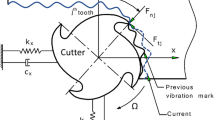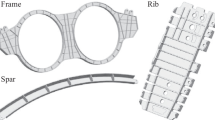Abstract
Exciting ternary-mechanism model considers the effects of flank shearing, flank ploughing and bottom ploughing and suits for the calibration of cutting force coefficients with a relatively lower axial depth of cuts in which the cutting force proportion of bottom edge gradually increases. Since the vibration velocities are not formulated in the empirical rubbing formulae, the process damping effect in chatter stability can not be modelled. In order to simultaneously guarantee the calibration accuracy of the cutting force coefficients and solve the chatter stability with process damping, a unified ternary-mechanism model is established in this article. First, the ploughing forces corresponding to the flank edge and bottom edge are formulated as the function of the indented area and the corresponding proportion factors based on Hertz contact theory. And the static and dynamic ternary cutting forces are explicitly formulated. Second, with the aid of the static equilibrium equation together with the expression of small disturbance, the dynamic model including ploughing-based process damping is established. Third, a fast procedure to calibrate the real-time cutting force coefficients is also derived based on the inverse process of static cutting force modelling. A series of test platforms are built to verify the correctness of the calibration method and the ploughing-based process damping model. Good consistency between the predicted and experimental results in both static cutting forces and dynamic chatter tests proves that above models have better accuracy.










Similar content being viewed by others
References
Duan XY, Peng FY, Yan R, Zhu ZR, Huang K, Li B (2016) Estimation of cutter deflection based on study of cutting force and static flexibility. Trans ASME J Manufac Sci Eng 138:041001
Liu B, Liu CF, Yu XL, Zhou Y, Wang DH (2022) Prediction, detection, and suppression of regenerative chatter in milling. Adv Mechanical Eng 14:1–26
Budak E, Altintas Y (1995) Modeling and avoidance of static form errors in peripheral milling of plates. Int J Mach Tools Manufac 35:459–476
Ko JH, Yun WS, Cho DW, Ehmann KF (2002) Development of a virtual machining system, Part I: approximation of the size effect for cutting force prediction. Int J Mach Tools Manufac 42:1595–1605
Endres WJ, DeVor RE, Kapoor SG (1995) A dual-mechanism approach to the prediction of machining forces, Part I: model development. Trans ASME J Eng Industry 117:526–533
Budak E, Altintas Y, Armarego EJA (1996) Prediction of milling force coefficients from orthogonal cutting data. Trans ASME J Manufac Sci Eng 118:216–224
Lin CJ, Lui YT, Lin YF, Wang HB, Liang SY, Wang JJJ (2021) Prediction of shearing and ploughing constants in milling of inconel 718. J Manufac Mater Process 5:8
Wan M, Ma YC, Feng J, Zhang WH (2016) Study of static and dynamic ploughing mechanisms by establishing generalized model with static milling forces. Int J Mechanical Sci 114:120–131
Wan M, Lu MS, Zhang WH, Yang Y (2012) A new ternary-mechanism model for the prediction of cutting forces in flat end milling. Int J Machine Tools Manufac 57:34–45
Agarwal A, Desai KA (2020) Importance of bottom and flank edges in force models for flat-end milling operation. Int J Adv Manufac Technol 107:1437–1449
Yang MY, Park HD (1991) The prediction of cutting force in ball-end milling. Int J Machine Tools Manufac 31:45–54
Feng HY, Menq CH (1994) The prediction of cutting forces in the ball-end milling process, Part I: Model formulation and model building procedure. Int J Machine Tools Manufac 34:697–710
Gradisek J, Kalveram M, Weinert K (2004) Mechanistic identification of specific force coefficients for a general endmill. Int J Machine Tools Manufac 44:401–414
Wang GF, Peng DB, Qin XD, Cui YH (2012) An improved dynamic milling force coefficients identification method considering edge force. J Mechanical Sci Technol 26:1585–1590
Ahmadi K, Ismail F (2012) Stability lobes in milling including process damping and utilizing multi-frequency and semi-discretization methods. Int J Machine Tools Manufac 54–55:46–54
Tunc L, Mohammadi Y, Budak E (2018) Destabilizing effect of low frequency modes on process damped stability of multi-mode milling systems. Mechanical Syst Signal Process 111:423–441
Li ZL, Zhu LM (2016) Mechanistic modeling of five-axis machining with a flat end mill considering bottom edge cutting effect. Trans ASME J Manufac Sci Eng 138:111012
Altintas Y, Stepan G, Merdol D, Dombovari Z (2008) Chatter stability of milling in frequency and discrete time domain. CIRP J Manufac Sci Technol 1:35–44
Guo Y, Lin B, Wang WQ (2019) Optimization of variable helix cutter for improving chatter stability. Int J Adv Manufac Technol 104:2553–2565
Mendieta LEU, Ozturk E, Sims ND (2021) Validation of variable helix milling instability islands, Proceedings of the Institution of Mechanical Engineers. Part B: J Eng Manufac 235:1682–1697
Sun YW, Jiang SL (2018) Predictive modeling of chatter stability considering force-induced deformation effect in milling thin-walled parts. Int J Machine Tools Manufac 135:38–52
Jiang SL, Sun YW (2020) Stability analysis for a milling system considering multi-point-contact cross-axis mode coupling and cutter run-out effects. Mechanical Syst Signal Process 141:106452
Altintas Y (2012) Manufacturing automation: metal cutting mechanics, machine tool vibrations, and CNC design, 2nd edn. Cambridge University Press, New York
Chiou RY, Liang SY (1998) Chatter stability of a slender cutting tool in turning with wear effect. Int J Mach Tools Manufac 38:315–327
Ahmadi K (2017) Analytical investigation of machining chatter by considering the nonlinearity of process damping. J Sound Vibration 393:252–264
Cao C, Zhang XM, Huang T, Ding H (2020) An improved semi-analytical approach for modeling of process damping in orthogonal cutting considering cutting edge radius, Proceedings of the Institution of Mechanical Engineers. Part B: J Eng Manufac 234:641–653
Tang XW, Peng FY, Yan R, Zhu ZR, Li ZP, Xin SH (2021) Nonlinear process damping identification using finite amplitude stability and the influence analysis on five-axis milling stability. Int J Mechanical Sci 190:106008
Takahashi W, Nakanomiya T, Suzuki N, Shamoto E (2021) Influence of flank texture patterns on the suppression of chatter vibration and flank adhesion in turning operations. Precision Eng 68:262–272
Li DH, Yip WS, Cao HR, Zhang HQ, Tang YM, To S (2023) Chatter suppression in diamond turning using magnetic field assistance. J Mater Process Technol 321:118150
Yao Q, Luo M, Zhang DH, Wu BH (2018) Identification of cutting force coefficients in machining process considering cutter vibration. Mechanical Syst Signal Process 103:39–59
Dang JW, Zhang WH, Yang Y, Wan M (2010) Cutting force modeling for flat end milling including bottom edge cutting effect. Int J Machine Tools Manufac 50:986–997
Altintas Y, Stepan G, Budak E, Schmitz T, Kilic ZM (2020) Chatter stability of machining operations. Trans ASME J Manufac Sci Eng 142:110801
Shaw MC, Desalvo GJ (1970) A new approach to plasticity and its application to blunt two dimensional indenters. Trans ASME J Eng Industry 92:469–479
Wu DW (1989) A new approach of formulating the transfer function for dynamic cutting process. Trans ASME J Eng Industry 111:37–47
Lotfi S, Rami B, Maher B, Gilles D, Wassila B (2019) Cutter-workpiece engagement calculation in 3-axis ball end milling considering cutter runout. J Manufac Process 41:74–82
Jiang SL, Zhan DN, Liu Y, Sun YW, Xu JT (2022) Modeling of variable-pitch/helix milling system considering axially varying dynamics with cutter runout offset and tilt effects. Mechanical Syst Signal Process 168:108674
Jin XL, Altintas Y (2011) Slip-line field model of micro-cutting process with round tool edge effect. J Mater Process Technol 211:339–355
Zhu LD, Liu CF (2020) Recent progress of chatter prediction, detection and supression in milling. Mechanical Syst Signal Process 143:106840
Bilgili D, Budak E, Altintas Y (2022) Multibody dynamic modeling of five-axis machine tools with improved efficiency. Mechanical Syst Signal Process 171:108945
Sykora HT, Bachrathy D, Stepan G (2019) Stochastic semi-discretization for linear stochastic delay differential equations. Int J Numerical Methods Eng 119:879–898
Yan ZH, Zhang CF, Jia JL, Ma BJ, Jiang XG, Wang D, Zhu TG (2022) High-order semi-discretization methods for stability analysis in milling based on precise integration. Precision Eng 73:71–92
Zhi HY, Zhang TS, Du J, Yan XG (2020) An efficient full-discretization method for milling stability prediction. Int J Adv Manufac Technol 107:4955–4967
Ji YJ, Wang LY, Song Y, Wang HJ, Liu ZB (2022) Investigation of robotic milling chatter stability prediction under different cutter orientations by an updated full-discretization method. J Sound Vibration 536:117150
Ahmadi K, Altintas Y (2014) Identification of machining process damping using output-only modal analysis. Trans ASME J Manufac Sci Eng 136:051017
Wan M, Lu MS, Zhang WH, Yang Y, Li Y (2011) A new method for identifying the cutter runout parameters in flat end milling process. Mater Sci Forum 697–698:71–74
Funding
This research has been supported by the National Natural Science Foundation of China under Grant no. 52105491.
Author information
Authors and Affiliations
Contributions
The authors declare that all co-authors participated in all the development stages of this article.
Corresponding author
Ethics declarations
Ethics approval
Not applicable
Consent to participate
Yes, consent to participate from all the authors.
Consent for publication
Yes, consent to publish from all the authors.
Conflict of interest
The authors declare no competing interests.
Additional information
Publisher's Note
Springer Nature remains neutral with regard to jurisdictional claims in published maps and institutional affiliations.
Rights and permissions
Springer Nature or its licensor (e.g. a society or other partner) holds exclusive rights to this article under a publishing agreement with the author(s) or other rightsholder(s); author self-archiving of the accepted manuscript version of this article is solely governed by the terms of such publishing agreement and applicable law.
About this article
Cite this article
Feng, J., Huang, Z., Huang, X. et al. A unified ternary-mechanism model for the calibration of cutting force coefficients and prediction of ploughing-based process damping in flank milling process. Int J Adv Manuf Technol 132, 1465–1480 (2024). https://doi.org/10.1007/s00170-024-13307-2
Received:
Accepted:
Published:
Issue Date:
DOI: https://doi.org/10.1007/s00170-024-13307-2




